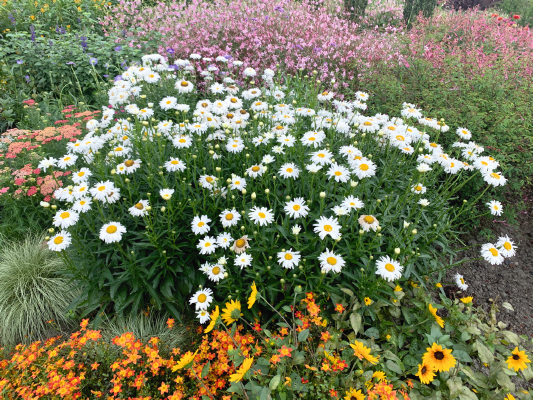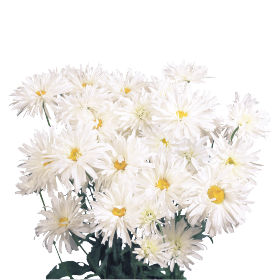
Crazy Daisy
- Fully double white flowers with quilled petals
- Ideal cut flower
- Attracts butterflies and other pollinators
- Crop Time
- Spring: 19 - 21 weeks
- Height ∅
- 26 ″ / 65 cm
- Exposure
- Sun - Partial shade
- Seed Form
- Raw Seed
- Heat Zone
- 12-1
- Hardiness Zone
- 4a-9b
- Product Use
- Bedding, Cutflower
Technical guide
Usage
Plants for border, pot and container plants, plants attract bees and butterflies, cut flower production, plants for rock garden
Sow time
January-April for green pots and cut flower production; outdoors June-August for flowering in pots the following year; June-August for cut flower production indoors with wintering
Sowing method
3-4 seeds per plug, sowing directly into pots is possible
Germination
Germinates in 9-12 days at 65-77 °F (25-25 °C). After sowing, cover seed lightly with vermiculite.
Growing on
Transplant plugs after 6 weeks. Grow on at 50-55 °F (12-13 °C) in a well-drained humus medium. Vernalization is required for flower initiation in all varieties. After vernalization, begin forcing plants at 60-65 °F (15-18 °C) for 7-8 weeks under long days.
Media
Use a well-drained, growing substrate with 15-30 % clay, 0-20 % parts (e.g. perlite, sand), 1,5-3 kg/m³ complete balanced fertilizer, 0-3 kg/m³ slow release fertilizer (3-9 months), iron-chelate, micronutrients, pH: 5.8-6.5. Field: loamy sandy to sandy humus soils with good drainage and good nutrition levels. Standard fertilization: 80-100 g/m² of a slow release fertilizer.
Temperature
Grow at 10-18 °C or outdoors. In winter indoors frost free at 3-5 °C or outdoors. Outdoors fleece cover needed. In spring the plants start to grow for 5-10 weeks at 13-18 °C and long day. Temperatures above 20 °C will increase the risk of infection with fungi and make the plant habit worse. Cold temperatures will increase the cultivation time. If cultivated at low light levels, the temperature should be cool for good stem quality. A chilling period (vernalization) for 10-12 weeks is recommended for flower initiation. This will improve uniformity and the quantity of the flowering. Without a chilling period the flowering is very limited.
Fertilization
Moderate-high fertilization levels are required. Fertilize the crop weekly with 100-150 ppm nitrogen (at 3 kg/m³ slow release fertilizer in substrate), using a complete balanced fertilizer. Avoid high ammonium and high nitrogen levels. Don’t fertilize after mid September. In spring fertilize 100-150 ppm nitrogen of a potassium balanced fertilizer (N: K₂O-ratio: 1:1,5). Prevent magnesium deficiency by applying magnesium sulphate (0,05 %) 1-2 times and in case of iron deficiency (above pH 6.0) apply iron-chelate for 1-2 times. Field: If necessary according to analysis, improve the soil with 80-100 g/m² of a slow release fertilizer, applied in several portions. Take care of possible iron deficiency and apply iron-chelate for 1-2 times. N min soil value: approximately 130 g N/m².
Stage I Starts with the radicle breaking through the testa. The roots are touching the medium. Ends with fully developed cotyledons.
Stage II Starts from fully developed cotyledons. Ends with the fully developed true leaf or true leaf pair.
Stage III Starts from the fully developed true leaf or true leaf pair and ends with 80% of the young plants being marketable.
Stage IV All young plants are ready for sale and in the process of being hardened off. This stage lasts about 7 days.
The cultural recommendations are based on results from trials conducted under Central European conditions. Different conditions in other parts of the world may lead to deviations in results achieved.
